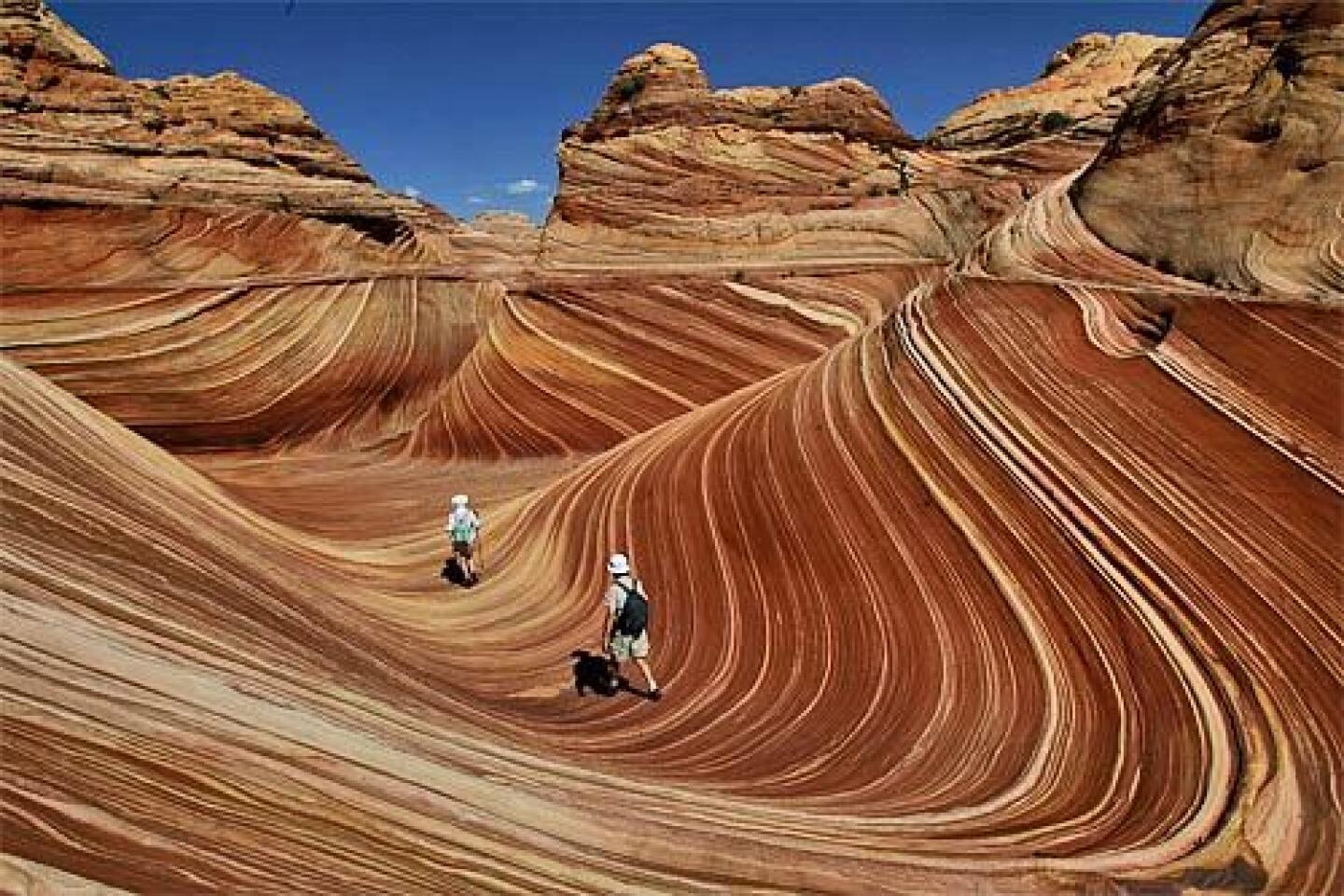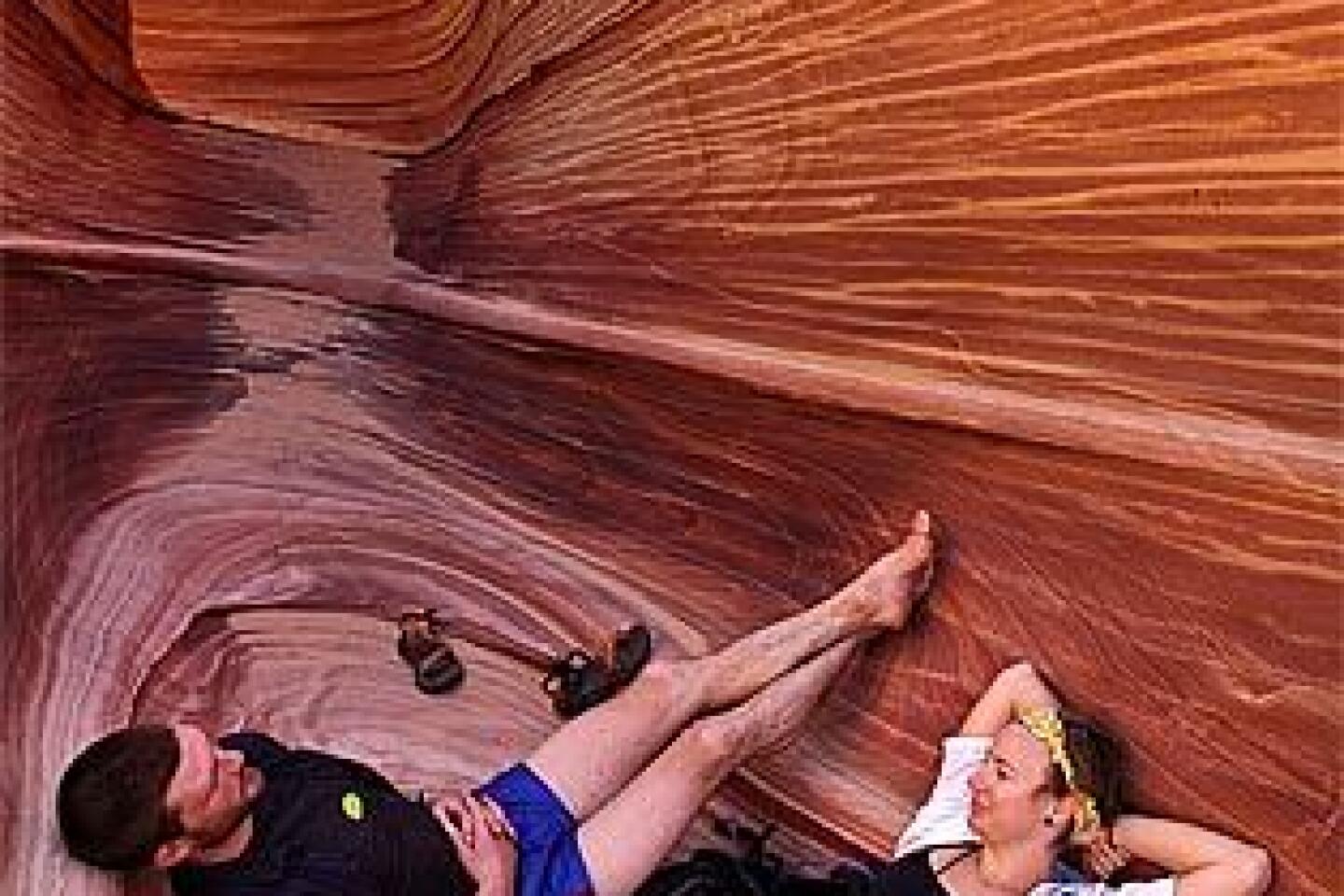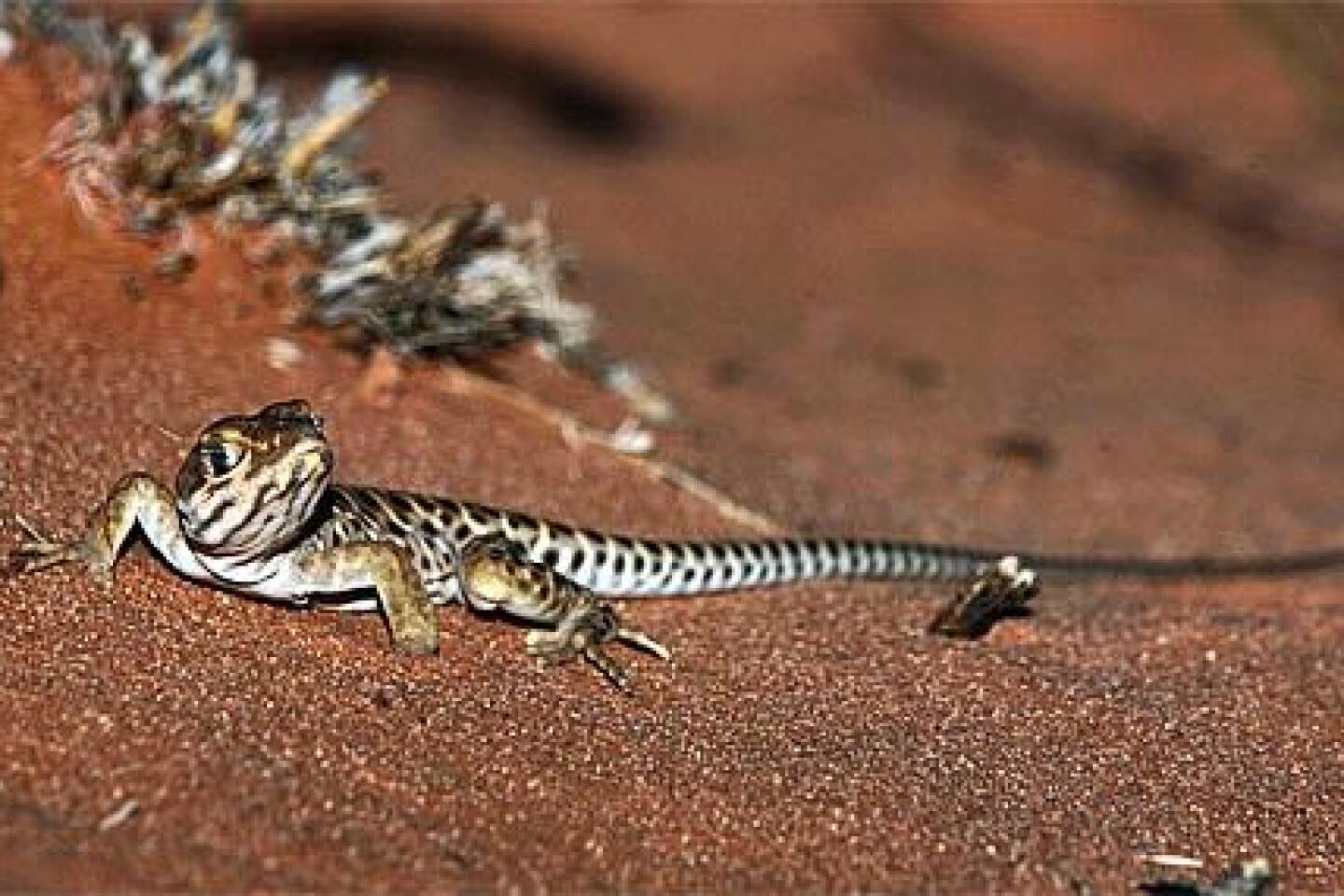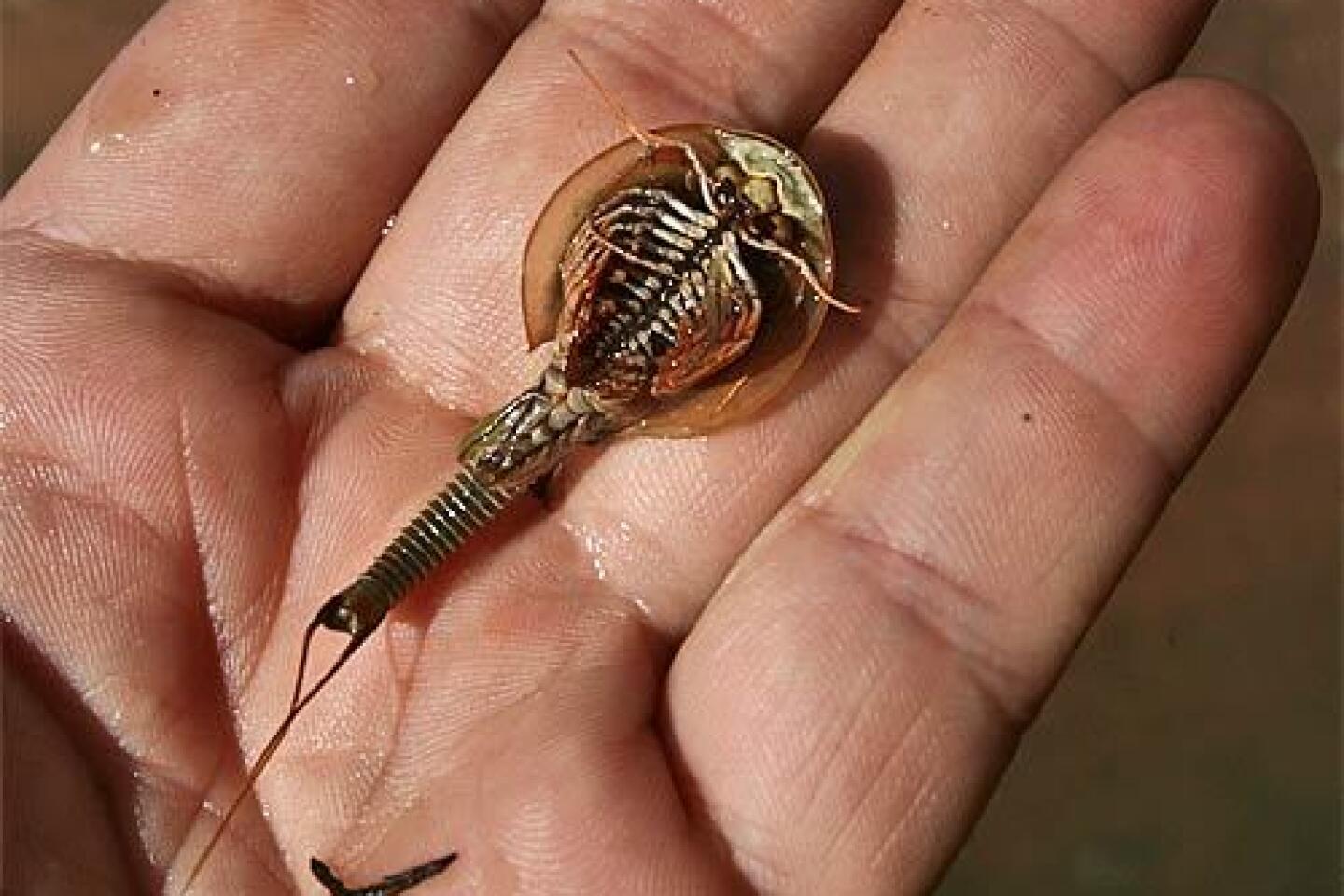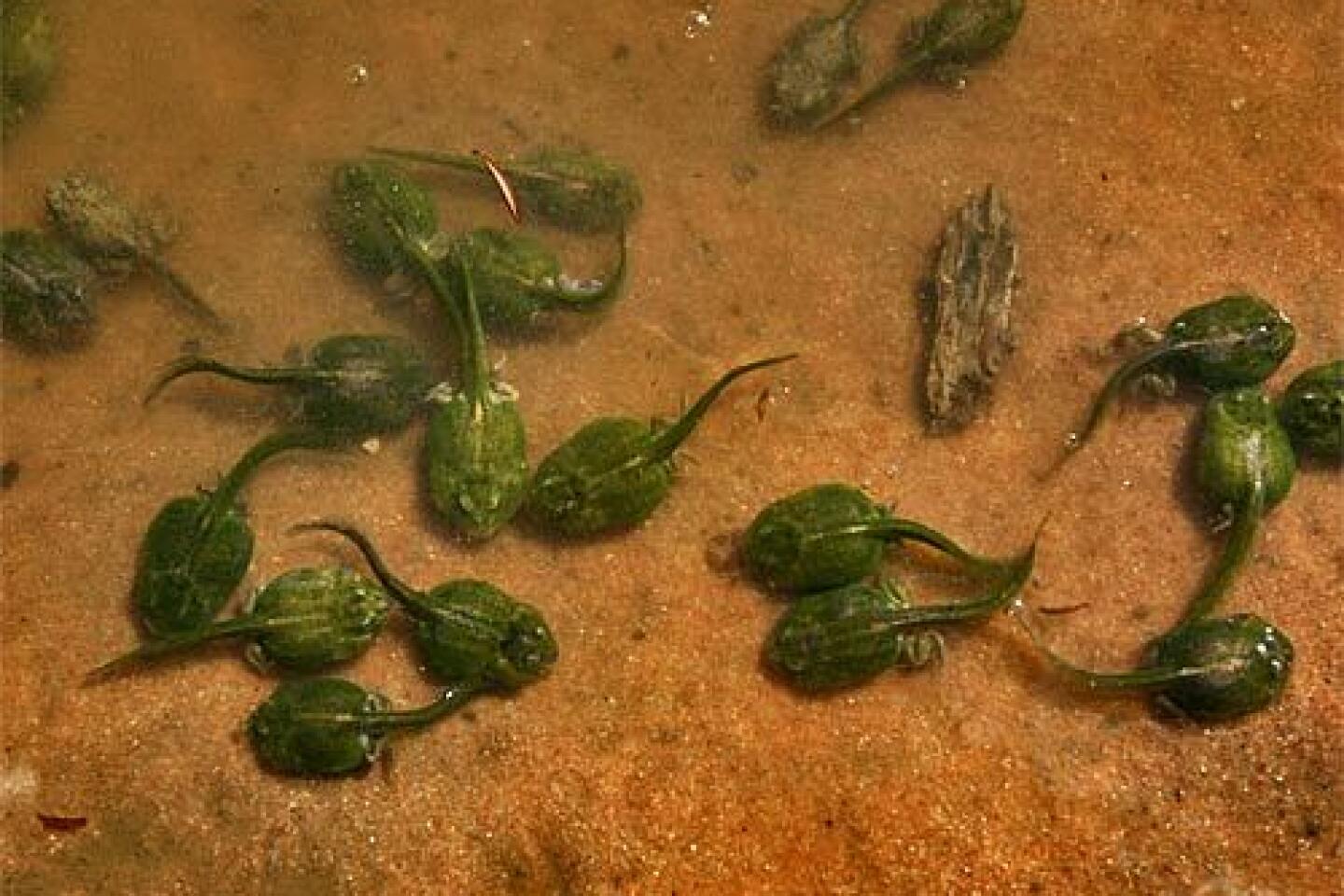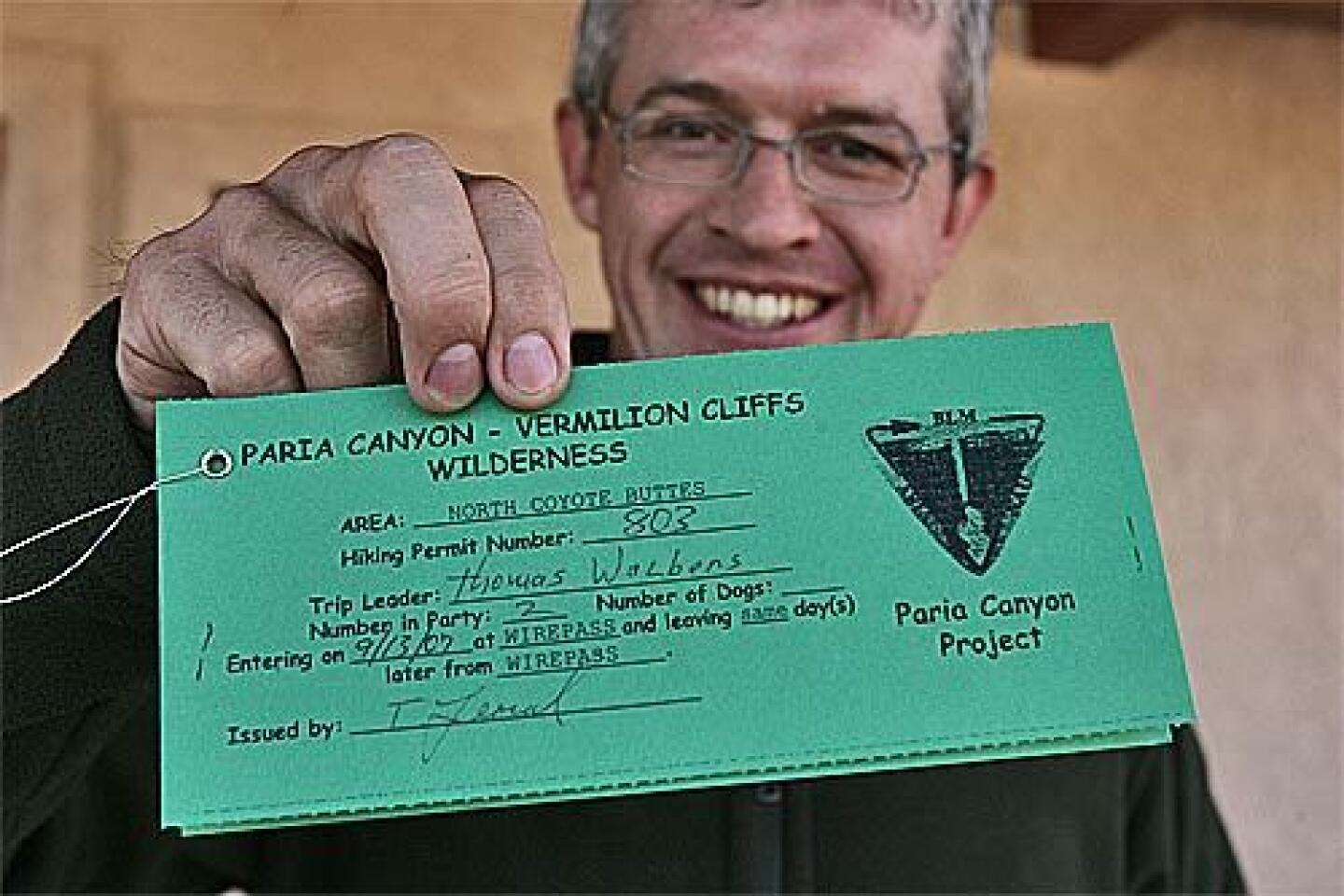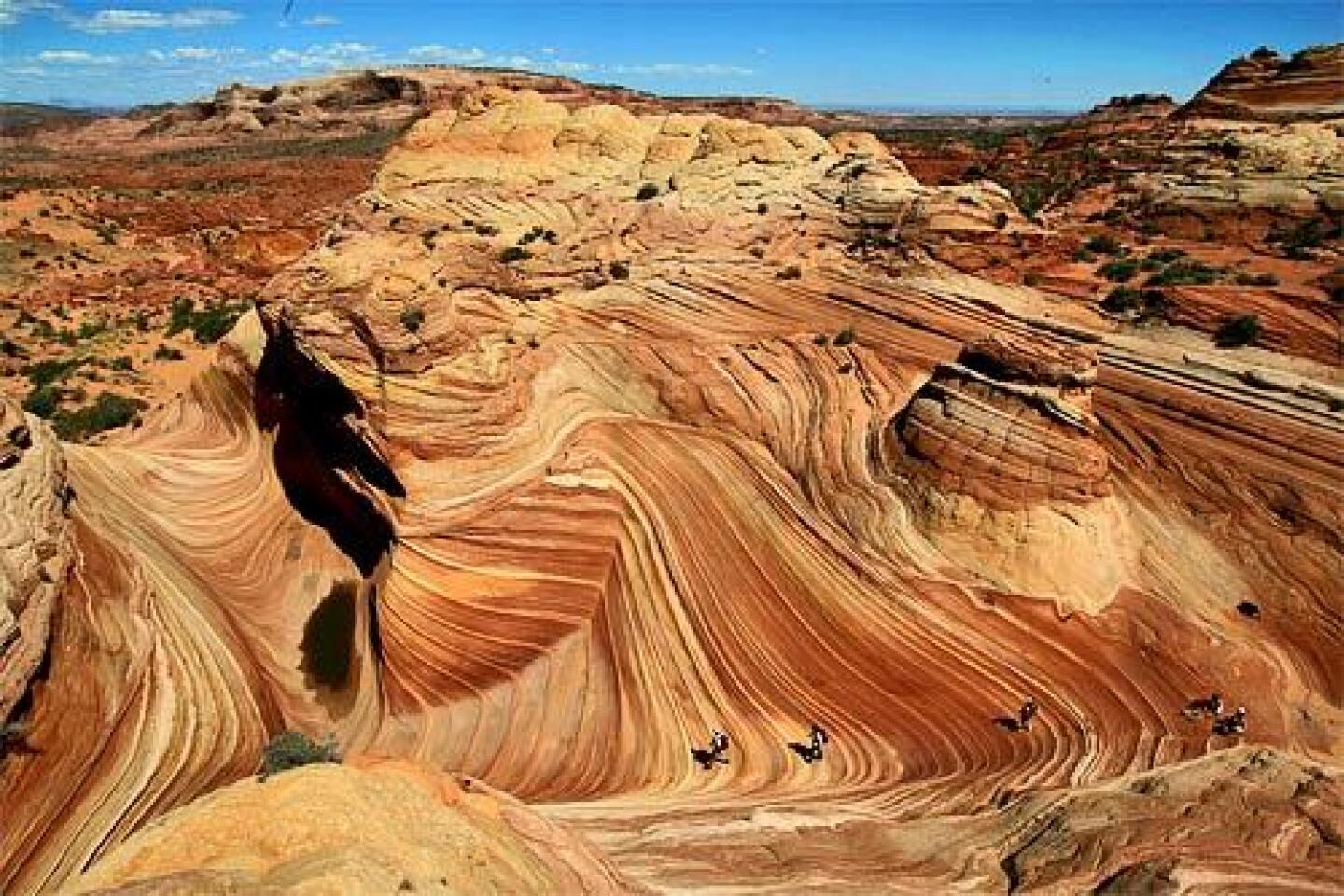Arizona’s Wave rock formation a stone-cold stunner
- Share via
Big Water, Utah
So there I was, standing with about 30 other hikers in boots and backpacks, jammed into a room no bigger than a double-wide in a one-story beige government building in a destitute moonscape otherwise known as southern Utah on a warm Friday morning.
If I sound surprised, I suppose I was. The day before I had flown to Flagstaff, Ariz., rented a car and driven more than two hours to Page, near the Utah border. I’d then gotten up early for a 30-minute drive to Big Water, only to find myself in the kind of hardscrabble wasteland that even rattlesnakes would be embarrassed to call home.
So, c’mon, who were all these people -- and why were they so eager to hit the trail? I never thought these parched, hellish deserts could draw a crowd -- unless you’re the Burning Man type.
Inside the crowded room, a staffer with the Bureau of Land Management started the ritual. He stood up tall behind a counter and began to drop a handful of numbered bingo balls into a small oval cage. The room fell quiet as he slowly turned the crank. Once the balls had jumped around a bit, he stopped and let one pop out of a hinged opening. He picked it up.
“Number one!” he shouted.
A young Seattle couple, standing nearby, let out a breath and grinned. They -- and eight other hikers in quick succession -- had just won a permit to hike into this wilderness, and they couldn’t be more thrilled.
“That’s it, folks,” the BLM worker announced with little emotion.
It was no big deal for him -- he does this every day -- but the losers weren’t happy at all. They grumbled and shuffled out to their cars, cursing and vowing to return.
OK, I shouldn’t have been surprised. This lottery determined who got to see the Wave, which, if you don’t know, is probably one of the most-photographed rock formations in North America. Apparently, you can’t call yourself a landscape photographer if you haven’t snapped a photo or two of the Wave. Only Hollywood’s terrible tabloid trio -- Britney, Paris and Lindsay -- have been in a camera view finder more than the Wave.
As a result, hikers and tourists from around the world have become fixated on this slice of sandstone, an obsession fueled by the thousands of glossies that fill hundreds of guidebooks and online galleries.
To keep the Wave from being damaged or overrun, the BLM allows no more than 20 visitors a day (10 from the on-site lottery and 10 from an online lottery), and during the peak spring and fall seasons, the odds of winning that treasured permit can be as high as 1 in 10. It’s so competitive that some hiker nerds devised a computer program to improve their chances of winning, which worked out pretty well -- or so I’m told -- until the BLM revamped the system last summer.
Now, I’d seen these photos. But you certainly couldn’t call me a Wave fanatic. I was drawn here by my cynicism. I expected an up-close tour of the Wave to fall way short of the hype. Call me a hater, but how many times have you read over-hyped stories about places that just don’t live up to the billing? It’s like when you meet your favorite celebrity, and he turns out to be a short, balding jerk. Still, I was curious.
And because I preferred not to make the trip to Big Water and be disappointed in return, I secured my permit months in advance by playing the BLM lottery online, a decent alternative to the drop of the bingo ball. I submitted my application by e-mail in July along with my $5 fee and learned a few days later that I had won one of 10 online permits for Sept. 12.
I was ready to be underwhelmed.
A TIE-DYED GUIDE
Once the crowds at the BLM office dispersed, I knew I had to hurry. I didn’t want to get caught plodding through the desert in the midday heat. The temperatures in the Paria Canyon-Vermilion Cliffs Wilderness can shoot from hot to infernal in a few short hours. Even lizards start looking for cover around noon.
Even though I had a well-marked map with color photos to guide me, I didn’t want to take a chance on getting lost. So I hired a guide.
In a tie-dyed shirt, blond ponytail, blue jeans and heavy work boots, Steve Dodson looked more like a 51-year-old Woodstock roadie than an outdoor guide. I met him at his restaurant, the Paria Outpost, about half a mile from the BLM field office near Big Water, Utah. When he’s not slicing up barbecue at his eatery, he’s leading tourists into the desert. He’s been doing this for more than 10 years.
We sped down a washboard road in his clattering red Suzuki Trooper, gravel and dirt spewing in our wake. He braked in a cloud of dust at the Wire Pass trail head, a gravel parking lot about eight miles south of U.S. 89.
From here, we began a three-mile trek across a rust-colored, nearly shadeless desert. The BLM suggests hikers carry at least a gallon of water for the trek; I brought a little more than that and wished I had more. We started at 10 a.m. and already I felt the fabric of my shirt melting on my back.
Our hike followed a dry wash for about half a mile before it cut through red sand dunes. Dodson told me he couldn’t remember how many times he’d been to the Wave. He assured me that the photos don’t do it justice. As a professional guide, he doesn’t have to mess with the BLM lottery, but he supports the permit limits, even though they tend to stifle his business.
“The wildlife experience is greatly enhanced with seclusion,” he said. “That’s why I like this area better than any other place.” Dodson seemed like a bright guy, but I was still skeptical. Could the Wave really be worth this trouble?
As we hiked, he listed half a dozen other strange and magical rock formations near the borders of Utah and Arizona, but the Wave, he told me, was different. So what makes it so special?
Talk to geologists and they’ll use words like “diagenetic coloration” and “stratigraphic relationships” to explain its colors and stripes. They might dumb it down and tell you that the Wave is made of Jurassic-age Navajo sandstone -- 190-million-year-old sand dunes turned to rock. Stacked one atop another, the dunes calcified in vertical and horizontal layers.
Iron oxides bled through to give the sandstone a salmon color. Hematite and goethite added yellows, oranges, browns and purples. It was all underground until water seeped through a huge vertical crack in a ridge above. The water cut a channel that was then scoured over thousands of years by wind-blown sand, carving out smooth curves and swells that look like cresting ocean waves.
It sounded wild, but really, it’s still just a big hunk of rock, right?
The farther Dodson led me toward the Wave, the more the landscape started to change. We marched through dry, flaking badlands, freckled with desert shrubs and an occasional juniper tree. We scrambled over red slickrock, scouting out our first landmark, a set of shapely buttes. We rested in the shade, watching a peregrine falcon hunt on the side of a red-and-beige mountain, etched with ridges that look like stretched muscles.
After a few minutes’ rest, we headed south, looking to a tall, gray ridge on the horizon for a huge vertical crack that marked the entrance to the Wave.
ROCK CANDY
Close your eyes and imagine yourself walking into a humongous vat of cinnamon taffy. That’s what went through my mind as we entered this weird, dreamlike world of swirling colors and psychedelic patterns. Maybe it was the desert heat, but it all looked like gooey taffy, stretched over huge mounds and 50-foot canyon walls. The surrounding buttes were heaps of melting rocky road ice cream.
The Wave is like an enormous Olympic-size swimming pool, with swooning, undulating walls lined with burnt sienna, pink, gray, turquoise and pale green. The bands mostly run horizontally, but at spots they zigzag and shimmy before falling back into their previous pattern.
It was nearly noon, and the temperature was pushing 100. A snow-cone vendor with a little pushcart would make a killing out here.
Voices echoed off the stone walls. Nearly all of the other 19 permit winners for that day milled around the multicolored canyon. A group of German tourists sat on a sandstone shelf, eating apples and taking photos. I asked how they had learned about this place, and one man muttered in a heavy German accent, “Internet . . . Google.”
Just as Dodson was telling me that the Wave gets more visits from Europeans than Americans, along came Susie Shults from St. George, Utah, who had brought her boyfriend to see the stony wonderland. It took her only three tries at the lottery to win a permit.
When she first walked into the Wave, Shults said she imagined herself flying, swooping down along the rocky surface, soaking up the colored bands and banking off the undulating canyon walls. Shults stopped in her tracks and sprawled face down on the canyon floor, her arms stretched wide.
At first it seemed odd, and I had to remind myself that this woman was not in the grip of some form of dementia. But I understood what she was feeling. This place is a hallucination set in stone. I asked Dodson if any of his guests tried to enhance the visit with mind-altering drugs. “That would be overkill,” he said.
While Dodson took a siesta in the shade of a small outcropping, I followed Shults and her boyfriend a few hundred yards to another phenomenon, known as the “Second Wave.” This stone feature is flatter, like an ocean swell, but tinged with brighter colors. To the west, we spotted a brown, bulbous rock shape that looked like a cheeseburger.
By 2 p.m. nearly all the other hikers had vanished into the desert. Dodson and I stayed to see how the afternoon light played on the colored rock. It took nature 190 million years to create this place. The least I could do was take my time enjoying it. The shadows on the ridges shifted, and the colors softened in the afternoon sun. I wandered around.
Overhead loomed a swirling caramel overhang. At my feet, I examined a slab of red rock that, in the afternoon light, looked like a tie-dyed masterpiece of lemon yellow and auburn. I snapped almost 100 digital photos, but I knew the images couldn’t convey the experience.
Just before I went to rouse Dodson from his afternoon catnap, I sat down in the base of a sunburned sandstone wave, resting my back on the cresting wall. I sat there for what seemed like an hour, naming the images I saw in the rocks, like a kid watching clouds take shape in the sky. Up above was a manta ray. Over there was a woman’s face and, in the distance, melted pizza toppings.
Eventually I called to Dodson, gave the Wave one last look and began marching back into the desert, toward those lovely, lonely buttes.
More to Read
Sign up for The Wild
We’ll help you find the best places to hike, bike and run, as well as the perfect silent spots for meditation and yoga.
You may occasionally receive promotional content from the Los Angeles Times.
